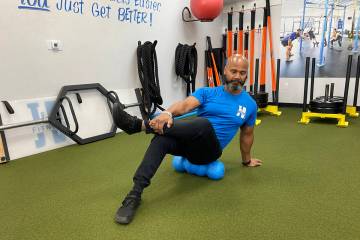She had two heart attacks at 26. Now she runs marathons.
Channing Muller woke up one Sunday morning feeling a little beat down. Being 26 and having gone out the night before, she figured it was an annoying, but run-of-the-mill, hangover and she just needed to sweat it out.
When she took a step out of bed, she immediately knew something else was going on.
Her heart started racing. Her breath quickened as if she’d just sprinted a 5K. And she was overcome with nausea.
Muller stumbled to her bathroom and looked in the mirror. Her skin was whiter than she’d ever seen it and covered with a sheen of sweat.
She crawled to her nightstand and grabbed her phone. Although she had a roommate, Muller knew she wasn’t strong enough to yell for help. When her roommate answered, Muller said, “Something’s wrong.”
When Muller arrived at the emergency room of a nearby hospital in Washington, D.C., her heart was still racing and she couldn’t get her breathing under control. Doctors tested the electrical signal in her heart and conducted two rounds of blood work.
Several hours later, they knew exactly what had happened:
She’d had a heart attack.
‘I want to run again’
Muller was airlifted to a cardiac care unit at another hospital, where more extensive testing revealed a 70 percent blockage of an artery to her heart. But her doctors were perplexed as to why she’d experienced a heart attack.
She had no obvious risk factors. She was an avid runner. She didn’t smoke. She had been a vegetarian for a decade and had no family history of heart disease. She didn’t have high blood pressure or overly high cholesterol.
Heart disease is the leading cause of death for women in the United States and can affect women at any age, according to the Centers for Disease Control and Prevention. In 2021, it was responsible for the deaths of 310,661 women — or about 1 in every 5 female deaths, the CDC reports.
Given Muller’s lack of risk factors and the level of blockage, her doctors expected she could control it through medication and monitoring. She was sent home to recover and told to begin cardiac rehabilitation in about a month.
A month later, her heart started racing again.
This time, she knew what was wrong.
Muller went straight to the hospital, where doctors confirmed a second heart attack. Her blockage had worsened to 90 percent.
Her medical team placed a stent in her artery so blood could flow in and out of the heart at a healthy rate.
When Muller started cardiac rehabilitation about a month later, she couldn’t walk more than a block without sitting down. She could barely hold a conversation without getting winded. And she found herself needing frequent long naps to make it through her days.
On the first day of rehab, a doctor asked her goal from the program. Without hesitating, she said: “I want to run again.”
Muller had been a runner since college and loved the sport. The month before her heart attack, she’d walked 60 miles over three days during a three-day cancer fundraiser. She came away wanting to run a half-marathon. And she wasn’t going to let her heart problems stop her now.
‘She did all the right things’
Slowly, but surely, Muller chipped away at her goal. She started with just a few minutes of cardiovascular activity. She wore a heart monitor. She worked with her doctors, dutifully ensuring she stayed within her fitness limits and not overextending herself or her heart.
She set her sights on a 10K hosted by the American Heart Association that was held six months after she started cardiac rehab.
“I wanted to run the whole thing without any walk breaks,” she said.
She checked that goal off the list and kept going.
Muller’s heart attack was in 2011. Since then, she’s run eight marathons — and counting. And she’s done it by applying the same philosophy that got her from walking a block to running a marathon.
“I really do approach every race and run, 1 mile at a time,” she said. She adds that while she wouldn’t choose to live a life with heart disease, she’s learned to accept the hand she’s been dealt, and find ways to still do the things she loves.
“The heart attacks really did teach me that I can’t take my fitness for granted. Even on the days where everything hurts or it’s hotter than Hades, it is a privilege to be able to run,” said Muller, who now lives in Chicago.
Dr. John Erwin, Muller’s current cardiologist, said her cautious and persistent approach has been a key part of how she’s been able to stay healthy and run long distances.
“She did all the right things and approached her return to running in a stepwise fashion,” said Erwin, clinical chair of the Department of Medicine at NorthShore Hospitals/Endeavor Health. “She started off with training for a 10K, then steadily increased her running, building upon her endurance and her confidence in how her heart is performing.”
He also noted that her quick response to her heart attacks set her up for long-term success, which can be especially vital for women, who can experience different symptoms from men, and may have a harder time identifying the signs of a heart attack. Erwin said Muller’s story speaks to how heart disease can affect anyone.
“Her heart recovered very quickly, because she sought medical treatment very quickly,” he said.




























